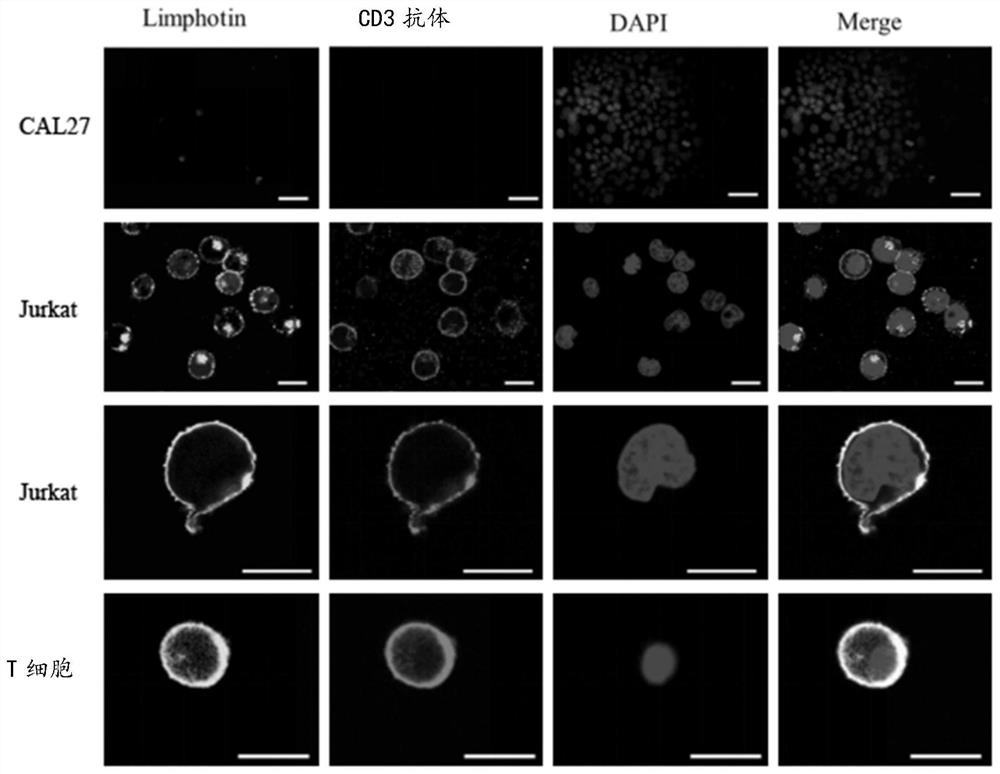A polypeptide specifically binding to CD3 and its application
A specific and reactive technology, applied in the field of non-antibody binding peptides, can solve the problems of mitogenicity, limited promotion and long-term medication
- Summary
- Abstract
- Description
- Claims
- Application Information
AI Technical Summary
Problems solved by technology
Method used
Image
Examples
Embodiment 1
[0044] Example 1: Screening and analysis of physicochemical properties of novel CD3 ligands
[0045] 1. Materials and methods
[0046] 1.1. Human liver cancer T7 phage cDNA library screening for novel CD3 ligands
[0047] According to the conventional peptide screening method, CD3ε recombinant protein was coated on a 96-well plate, and T7 phage was added to incubate at room temperature for 30 min the next day. After washing with TBST, T7 phage eluent was incubated at room temperature for 10-20 min to elute the phage bound to CD3ε recombinant protein. It was added to 6 ml of shaken BLT5403 host bacteria (Novagen Company), and the bacteria were shaken at 37° C. until lysed. The phage screening process was repeated four times, and the binding ability of the phage monoclonal to the CD3ε recombinant protein was detected by ELISA.
[0048] 1.2. Identification of phage insertion sequence by PCR and sequencing
[0049] After the above four rounds of phage screening, 46 phage plaque...
Embodiment 2
[0069] Example 2 Study on cell binding specificity of Limhotin
[0070] 1. Materials and methods
[0071] Jurkat cells: Human acute T lymphocytic leukemia cells (Cell Bank of the Type Culture Collection Committee of the Chinese Academy of Sciences);
[0072] Cal27 cells (or called CAL27 cells): human tongue squamous cell carcinoma cell line (Cell Bank of Type Culture Collection Committee, Chinese Academy of Sciences);
[0073]CTSC-2 cells: human tongue squamous cell carcinoma cell line (constructed in our laboratory)
[0074] PBMC cells: human peripheral blood mononuclear cells;
[0075] 1.2 Immunofluorescence analysis of Limhotin binding to Jurkat cells, PBMC cells, and CAL27 cells
[0076] Culture Jurkat cells, PBMC cells, and CAL27 cells in 6-well plates. When the cell density grows to about 70%, add 5 μM Limhotin polypeptide respectively. The negative control group is the same amount of polypeptide dissolution reagent. After incubation for 30 minutes, 4% PFA Fix with r...
Embodiment 3
[0093] Example 3 Research on Cell Regulatory Function of Limhotin
[0094] 1. Experimental reagents
[0095]
[0096] 2. Experimental method
[0097] 2.1. Cell Viability Detection
[0098] Add 10 to 96-well culture plate 4 For Jurkat, PBMC and CAL27 cells, the treatment group was added with gradient concentration of Limhotin. After culturing for 24h, 48h and 72h, 10 μl of CCK-8 solution was added to each well of Jurkat and CAL27 cells, and the absorbance at 450nm was measured by a multifunctional microplate reader. Calculation of relative cell activity: relative cell activity=(OD value of cells in experimental group-OD value of cells in blank group) / (OD value of cells in negative control group-OD value of cells in blank group)×100%.
[0099] Add 100 μl of cell titer glo reagent to PBMC cells, transfer the liquid to an opaque black 96-well plate, measure the fluorescence value CPS with a multi-functional microplate reader, and calculate the relative cell activity: Relativ...
PUM
| Property | Measurement | Unit |
|---|---|---|
| affinity | aaaaa | aaaaa |
Abstract
Description
Claims
Application Information
 Login to View More
Login to View More - R&D
- Intellectual Property
- Life Sciences
- Materials
- Tech Scout
- Unparalleled Data Quality
- Higher Quality Content
- 60% Fewer Hallucinations
Browse by: Latest US Patents, China's latest patents, Technical Efficacy Thesaurus, Application Domain, Technology Topic, Popular Technical Reports.
© 2025 PatSnap. All rights reserved.Legal|Privacy policy|Modern Slavery Act Transparency Statement|Sitemap|About US| Contact US: help@patsnap.com



